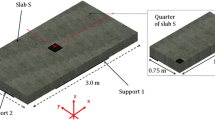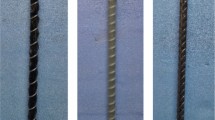Abstract
The analysis of tests conducted on small-scale slabs at ambient and elevated temperatures is presented in this paper. The slabs were produced from a new type of concrete containing different levels of glass sand and basalt fibre. Two methods were used for this purpose: a simplified method developed previously and a finite element method, using the software package ABAQUS. For the slabs at ambient temperature, the results showed a good correlation for the load–displacement relationship between the test and the two models up to the failure loads. For the slabs at elevated temperature, the ABAQUS model gave a reasonable prediction for the temperature–displacement relationship while the simplified method gave a conservative prediction for the maximum allowable vertical displacement. As a result, the simplified method underestimated the temperature at which the reinforcement fracture occurs for this type of concrete slab, incorporating glass sand and basalt fibres. Further work is required to remove this conservatism from the simplified design method for this type of concrete.









Similar content being viewed by others
Abbreviations
- e :
-
Enhancement due to membrane action
- f cu :
-
Compressive cube strength of concrete
- P :
-
Theoretical yield line load
- P test :
-
Maximum sustained load from the test
- T Bot :
-
Temperature at the bottom of the slab
- T Mesh :
-
Temperature of the slab reinforcement
- T Pred :
-
Predicted temperature
- T Test :
-
Test temperature
- T top :
-
Temperature at the top of the slab
- ΔABAQUS :
-
Maximum displacement predicted by ABAQUS
- ΔFire :
-
Maximum vertical displacement at failure for elevated temperature tests
- Δmax :
-
Maximum displacement
- ΔTest :
-
Maximum displacement recorded in the test
- ρ :
-
Reinforcement ratio
References
Bailey C, Lennon T, Moore D (1999) The behaviour of full-scale steel-framed buildings subjected to compartment fires. Struct Eng 77:15–21
Bailey C, Moore D (2000) The structural behaviour of steel frames with composite floorslabs subject to fire. Pt. 2: design. Struct Eng 78:19–27
Lange DJ (2009) Risk and performance based fire safety design of steel and composite structures, PhD thesis, The University of Edinburgh
Cameron N, Usmani A (2005) New design method to determine the membrane capacity of laterally restrained composite floor slabs in fire. Part 1: theory and method. Struct Eng 83:28–33
Wood R (1961) Plastic and elastic design of slabs and plates: with particular reference to reinforced concrete floor slabs. Thames and Hudson, London
Taylor R (1965) A note on a possible basis for a new method of ultimate load design of reinforced concrete slabs. Mag Concr Res 17(53):183–186
Sawczuk A, Winnicki L (1965) Plastic behavior of simply supported reinforced concrete plates at moderately large deflections. Int J Solids Struct 1(1):97–110
Hayes B (1968) Allowing for membrane action in the plastic analysis of rectangular reinforced concrete slabs. Mag Concr Res 20(65):205–212
Bailey C, White D, Moore D (2000) The tensile membrane action of unrestrained composite slabs simulated under fire conditions. Eng Struct 22(12):1583–1595
Bailey C (2001) Membrane action of unrestrained lightly reinforced concrete slabs at large displacements. Eng Struct 23(5):470–483
Bailey CG (2003) Efficient arrangement of reinforcement for membrane behaviour of composite floor slabs in fire conditions. J Constr Steel Res 59(7):931–949
Bailey CG, Toh WS (2007) Behaviour of concrete floor slabs at ambient and elevated temperatures. Fire Saf J 42(6–7):425–436
Newman GM, Robinson JT, Bailey CG (2000) Fire safe design: a new approach to multi-story steel-framed buildings, SCI publication, London, p 288
Bailey CG (2001) Steel structures supporting composite floor slabs: design for fire. BRE digest 462, The Building Research Establishment, Watford
Newman GM, Robinson JT, Bailey CG (2006) Fire safe design: a new approach to multi-story steel-framed buildings, 2nd edn. SCI publication, Ascot, p 288
Borhan TM (2012) Properties of glass concrete reinforced with short basalt fibre. Mater Des 42:265–271
Sim J, Park C, Moon D (2005) Characteristics of basalt fiber as a strengthening material for concrete structures. Compos B Eng 36(6–7):504–512
Borhan TM, Bailey CG (2013) Structural behaviour of basalt fibre reinforced glass concrete slabs. Mater Struct. doi:10.1617/s11527-013-0046-0
Bailey CG, Toh WS (2007) Small-scale concrete slab tests at ambient and elevated temperatures. Eng Struct 29(10):2775–2791
BSEN1993:1-2 (2005) Eurocode 3: design of steel structures. Part 1-2. General rules. Structural fire engineering, British Standards, London
BSEN1992:1-2 (2004) Eurocode 2, design of concrete structures. General rules—structural fire design. British Standards, London
CEB-FIP Model Code 1990 (1993) Thomas Telford Ltd., London
Hordijk D (1991) Local approach to fatigue of concrete, PhD thesis, Delft University of Technology
Malm R (2006) Shear cracks in concrete structures subjected to in-plane stresses. Trita-BKN. Bulletin 88
Lubliner JJ, Oliver SO, Onate E (1989) A plastic-damage model for concrete. Int J Solids Struct 25(3):229–326
Chan BM (2008) Membrane action of concrete floor slabs at ambient and elevated temperatures. University of Manchester, Manchester, p 286
Takeuchi M, Hiramoto M, Kumagai N, Yamazaki N, Kodaira A, Sugiyama K (1993) Material properties of concrete and steel bars at elevated temperatures. In: Proceedings of Structural Mechanics in Reactor Technology (SMiRT 12), pp 133–138
Chan YN, Peng GF, Anson M (1999) Residual strength and pore structure of high-strength concrete and normal strength concrete after exposure to high temperatures. Cem Concr Compos 21(1):23–27
Dias W, Khoury G, Sullivan P (1990) Mechanical properties of hardened cement paste exposed to temperatures up to 700 C (1292 F). ACI Mater J 87(2):160–166
Author information
Authors and Affiliations
Corresponding author
Rights and permissions
About this article
Cite this article
Borhan, T.M., Bailey, C.G. Modelling basalt fibre reinforced glass concrete slabs at ambient and elevated temperatures. Mater Struct 47, 999–1009 (2014). https://doi.org/10.1617/s11527-013-0109-2
Received:
Accepted:
Published:
Issue Date:
DOI: https://doi.org/10.1617/s11527-013-0109-2




